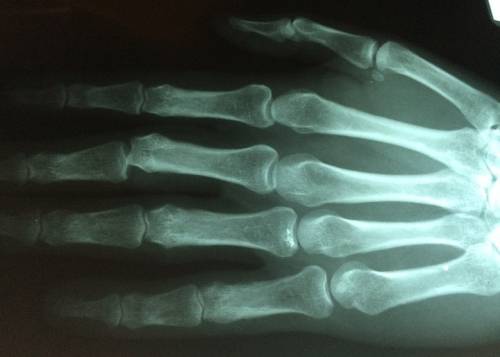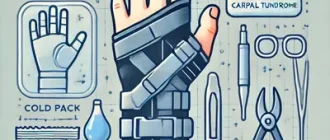Healing from a fractured hand can present difficulties, but by obtaining accurate information and proper guidance, you can enhance the pace of your recovery. In this context, we will discuss the typical duration required to heal a broken hand, based on reliable data.
Whether you’re looking to regain strength for daily activities or get back into sports, understanding the timeline of healing is essential. So, let’s explore the facts and discover how long it takes to recover from a broken hand.
How does a broken hand happen?
A broken hand can happen due to various reasons, including accidents, falls, sports injuries, or physical altercations. The most common cause is direct trauma or impact to the hand, such as hitting it against a hard surface or getting it caught in an object. It can also occur from excessive force or stress on the hand, like in the case of fractures caused by repetitive motions or overuse injuries.
The severity of the fracture can range from minor hairline cracks to complete breaks that result in displacement or misalignment of the bones. It is important to seek immediate medical attention if you suspect you have a broken hand in order to receive appropriate diagnosis and treatment.
Types of hand fractures
Types of hand fractures can vary depending on the location and severity of the injury. The following are the most common types of hand fractures:
- Metacarpal Fracture: This type of fracture occurs in the long bones of the hand, known as metacarpals. It can be a result of direct trauma or from excessive force on the hand.
- Phalangeal Fracture: Phalanges are the bones in the fingers. Fractures in this area can involve the proximal phalanx (closest to the hand), middle phalanx, or distal phalanx (closest to the fingertip).
- Boxer’s Fracture: A boxer’s fracture is a type of fracture that occurs in the fifth metacarpal, which connects to the pinky finger. It usually happens when a person punches with a closed fist.
- Bennett’s Fracture: This type of fracture occurs at the base of the thumb where it joins the wrist. It is usually caused by a forceful impact to the hand, such as a fall or car accident.
- Scaphoid Fracture: The scaphoid bone is located near the base of the thumb. Fractures in this bone can be challenging to diagnose and may require specialized treatment.
- Phalangeal Shaft Fracture: This type of fracture occurs in the middle section of the finger bones. It can happen due to impact or crushing injuries.
- Complex Fracture: A complex fracture involves multiple fractures or additional injuries, such as dislocation or soft tissue damage.
Diagnosing the type and severity of the fracture is essential for determining the appropriate treatment and estimating the recovery time. If you suspect a hand fracture, it is crucial to seek medical attention promptly for an accurate diagnosis and proper treatment plan.
Signs and symptoms of a broken hand
The signs and symptoms of a hand fracture can differ based on how severe and where the break is. Below are some typical indicators:
- Pain: Sharp or throbbing pain is often experienced at the site of the fracture.
- Swelling: Swelling around the injured area is a common symptom of a broken hand.
- Bruising: Discoloration and bruising may appear around the affected hand and fingers.
- Deformity: The hand may look misshapen or have an abnormal alignment if a fracture is present.
- Limited mobility: Difficulty in moving or rotating the hand or fingers is a clear sign of a break.
- Numbness: Numbness or tingling sensation in the hand or fingers may indicate nerve damage.
- Difficulty gripping: Inability to grasp objects firmly due to pain or weakness.
If you experience any of these symptoms after an injury, it is important to seek medical attention to have your hand properly evaluated and treated.
Treatment options for a broken hand
There are different choices available for the treatment of a broken hand, depending on how severe and where the fracture is located. For less severe cases where the bone is still in the correct position, a cast or splint can be used to keep the hand stable and aid in the healing process. Typically, this is worn for a few weeks.
For more complex fractures or cases where the bone is misaligned, surgery may be necessary. This could involve realigning the bones and using screws, plates, or pins to hold them in place during the healing process. Surgery may also be recommended if there are other associated injuries, such as damage to nerves or blood vessels.
In addition to immobilization or surgery, pain management is an important aspect of treatment. Over-the-counter pain medications may be recommended, or stronger prescription medications may be necessary in some cases. Physical therapy may also be prescribed to help restore strength and mobility in the hand once the fracture has healed.
It’s important to follow the treatment plan recommended by your doctor and to attend follow-up appointments to monitor the healing process. Every case is unique, and the recovery time will vary depending on factors such as the severity of the fracture, the individual’s overall health, and adherence to the treatment plan.
The recovery process for a broken hand
The recovery process for a broken hand typically involves the following steps:
- Immobilization: To allow the broken bones to heal properly, a splint, cast, or brace is applied to immobilize the hand and wrist. This helps to reduce pain, prevent further damage, and promote proper alignment during healing.
- Pain management: Over-the-counter pain medications or prescribed pain relievers may be recommended to manage pain and discomfort during the recovery period.
- Physical therapy: Once the initial healing phase is complete, physical therapy may be prescribed to regain strength, flexibility, and range of motion in the hand and fingers. Therapy exercises may include finger and hand movements, grip strengthening, and stretching exercises.
- Gradual return to activities: Depending on the severity of the fracture and the individual’s progress, a gradual return to normal activities and sports may be recommended. This is typically done under the guidance of a healthcare professional to ensure that the hand is fully healed and strong enough to withstand the demands of specific activities.
- Monitoring: During the recovery process, regular follow-up appointments with a healthcare provider are essential to monitor the healing progress, address any concerns or complications, and make any necessary adjustments to the treatment plan.
- Compliance with treatment: Following the prescribed treatment plan, including wearing the immobilization device as directed, attending physical therapy sessions, and adhering to any activity restrictions, is crucial for a successful recovery.
It is important to note that the recovery time for a broken hand can vary depending on factors such as the location and severity of the fracture, the individual’s age and overall health, and adherence to the treatment plan. In most cases, it can take several weeks to several months for a broken hand to heal completely.
For specific sports-related recovery times for a broken hand, such as in the NBA, baseball, football, hockey, and tennis, it is recommended to consult with a healthcare professional or sports medicine specialist who can provide tailored guidelines and timelines based on the individual’s condition and sport-specific demands.
In NBA
When it comes to a broken hand, athletes in the NBA face unique challenges during the recovery process. Professional basketball players rely heavily on their hands for shooting, dribbling, and passing, making hand injuries particularly problematic. The recovery time for a broken hand in the NBA can vary depending on the severity of the fracture and the player’s dedication to rehabilitation.
During the recovery process, NBA players work closely with team medical staff and physical therapists to regain strength, flexibility, and range of motion in their hand. They undergo a series of exercises and therapies, including hand and finger exercises, grip strengthening, and proprioception training to improve coordination and fine motor skills.
Returning to playing basketball depends on the individual’s progress and clearance from medical professionals. Some players may need to wear protective splints or casts during games to prevent reinjury. It is crucial for NBA players to follow their rehabilitation protocols diligently to ensure a successful recovery and minimize the risk of long-term complications that could affect their performance on the court.
In baseball
In baseball, a broken hand can significantly impact a player’s ability to play the game. The recovery process for a broken hand in baseball can take several weeks to months, depending on the severity of the injury and the individual’s healing ability. Following the initial injury, players will typically undergo a period of immobilization, often with a cast or splint, to allow the bones to heal properly. Physical therapy and rehabilitation exercises are then necessary to restore strength, flexibility, and range of motion in the hand. It is crucial for baseball players to work closely with their medical team and follow a structured rehabilitation program to ensure a safe and successful return to the sport.
In football
In football, a broken hand can be a common injury due to the high impact and physical nature of the sport. Depending on the severity of the fracture, the recovery process may vary. Typically, a player will undergo treatment such as immobilization with a cast or splint to allow the bones to heal properly. They may also receive pain medication and undergo physical therapy to restore strength and range of motion.
The recovery time for a broken hand in football can range from a few weeks to several months, depending on the extent of the injury and the individual’s healing process. Factors such as the location of the fracture, the player’s overall health, and adherence to the rehabilitation program can also affect the recovery time.
During the recovery process, football players may need to modify their training and playing activities to avoid further injury. They may also work closely with athletic trainers and medical professionals to gradually return to full contact and game play.
It is important for football players to follow their healthcare provider’s instructions and recommendations for a faster and successful recovery. This may include wearing protective gear, participating in strengthening exercises, and practicing proper tackling and blocking techniques to minimize the risk of re-injury.
In hockey
In hockey, a broken hand can occur due to direct impact from a stick, puck, or collision with an opponent or the boards. The recovery process for a broken hand in hockey is similar to that of other sports.
After the injury, the player will undergo medical evaluation, which may include X-rays or other imaging tests to determine the extent of the fracture. Treatment options for a broken hand in hockey can range from non-surgical methods, such as casting or splinting, to surgical interventions, such as internal fixation with screws or plates.
The recovery time for a broken hand in hockey can vary depending on the severity of the fracture and the individual’s healing process. It typically takes around 6-8 weeks for the bones to heal, but it may take longer for athletes to fully recover and regain their pre-injury strength and range of motion.
During the recovery process, hockey players may undergo physical therapy and rehabilitation exercises to promote healing, reduce swelling, and regain hand function. They may also wear protective equipment, such as gloves with added padding or a customized brace, to prevent further injury and support the healing process.
In tennis
In tennis, a broken hand can significantly impact a player’s ability to compete and perform at their best. The recovery process for a broken hand in tennis typically involves a combination of rest, immobilization, physical therapy, and gradual return to play.
Depending on the severity of the fracture, a player may need to wear a cast or splint and refrain from participating in tennis activities for several weeks or even months. It is crucial for players to follow their healthcare provider’s recommendations and engage in rehabilitative exercises to regain strength, flexibility, and range of motion in the hand.
Additionally, players may need to modify their grip or technique to accommodate any lingering weakness or discomfort in the hand. The length of recovery time may vary depending on the individual and the specific circumstances of the injury.
Factors that can affect the recovery time
Several factors can affect the recovery time for a broken hand. These include:
- Severity of the fracture: The type and severity of the fracture can significantly impact the recovery time. Simple fractures may heal in a few weeks, while more complex fractures may require several months of healing and rehabilitation.
- Age and overall health: Younger patients generally heal faster than older individuals. Additionally, overall health and the presence of any underlying medical conditions can affect the body’s ability to heal and recover.
- Treatment approach: The chosen treatment approach, such as casting, surgery, or the use of external fixation devices, can influence the recovery time. Some treatment methods may require longer periods of immobilization and rehabilitation.
- Compliance with treatment plan: Following the prescribed treatment plan, including proper rest, immobilization, physical therapy, and lifestyle modifications, is crucial for optimal healing. Non-compliance or premature return to activities can prolong the recovery process.
- Rehabilitation and therapy: The timely initiation and adherence to rehabilitation and therapy programs are vital for restoring hand function and maximizing recovery. These programs may include exercises, splinting, and occupational therapy.
- Individual factors: Every individual’s healing process is unique, and factors such as genetics, overall fitness, and lifestyle choices can influence the speed of recovery.
It is important to note that each case of a broken hand is different, and recovery times can vary. It is best to consult with a healthcare professional for an accurate assessment and personalized guidance for a successful recovery.
Tips for a faster and successful recovery
Here are some tips for a faster and successful recovery from a broken hand:
- Follow your doctor’s instructions: It’s important to adhere to the treatment plan prescribed by your doctor or orthopedic specialist. This may include wearing a cast or splint, attending physical therapy sessions, taking prescribed medication, and following any restrictions on activities.
- Ice and elevate: Using ice packs and elevating your hand above the level of your heart can be helpful in reducing swelling and relieving pain. To prevent frostbite, it is important to place a thin cloth or towel between your skin and the ice pack.
- Take pain relievers: Over-the-counter pain medications like acetaminophen or ibuprofen can help manage pain and reduce swelling. Always consult with your doctor before taking any medication.
- Maintain a healthy diet: Proper nutrition is essential for healing. Focus on eating a well-balanced diet that includes lean proteins, fruits and vegetables, whole grains, and foods rich in essential vitamins and minerals.
- Keep the area clean and dry: Follow proper hygiene practices to prevent infection. Avoid getting the cast or splint wet, and use a plastic bag or waterproof covering when showering.
- Perform gentle exercises: As instructed by your doctor or physical therapist, perform gentle exercises to improve range of motion, flexibility, and prevent stiffness. Avoid any strenuous activities that could potentially re-injure your hand.
- Use adaptive equipment: Depending on the severity of your injury, your doctor may recommend using adaptive equipment such as a splint or brace to provide additional support and protect your hand during the recovery process.
- Avoid smoking and alcohol consumption: Smoking and alcohol consumption can impair the healing process. Quit smoking if you’re a smoker and alcohol intake.
- Stay positive and patient: Recovery takes time, and it’s important to stay positive and patient throughout the healing process. Surround yourself with a support system, engage in activities that promote relaxation and stress reduction, and celebrate small milestones along the way.
Remember, every individual’s recovery time may vary depending on factors such as the severity of the fracture, overall health, age, and adherence to the treatment plan. It’s best to consult with your doctor or orthopedic specialist for personalized advice and guidance on your specific case.
When to expect full recovery
The duration for complete recovery from a hand fracture can differ based on several elements such as the extent of the break, the treatment method employed, and the individual’s overall health and healing capacity. Generally, it can take anywhere from a few weeks to several months for a broken hand to fully mend.
For simple fractures that do not require surgery, full recovery is typically expected within 6-8 weeks. This includes the time it takes for the bone to heal and regain its strength, as well as any necessary rehabilitation or physical therapy to restore range of motion and strength in the hand.
However, more complex fractures or those that require surgical intervention may take longer to heal. Surgery may be necessary to realign the broken bones or to stabilize them with plates, screws, or pins. In these cases, the recovery time can range from 3-6 months or longer, depending on the specifics of the injury and the individual’s healing process.
It’s important to note that the recovery time can also be influenced by the individual’s compliance with their treatment plan and rehabilitation exercises. Following the doctor’s instructions, attending therapy sessions, and taking any prescribed medications or wearing splints or casts as directed can help speed up the healing process and ensure a successful recovery.
Every individual’s healing process is unique, so it’s essential to consult with a healthcare professional for an accurate assessment of the expected recovery time for a specific broken hand injury.
About the Author
Reyus Mammadli is the author of this health blog since 2008. With a background in medical and biotechnical devices, he has over 15 years of experience working with medical literature and expert guidelines from WHO, CDC, Mayo Clinic, and others. His goal is to present clear, accurate health information for everyday readers — not as a substitute for medical advice.







